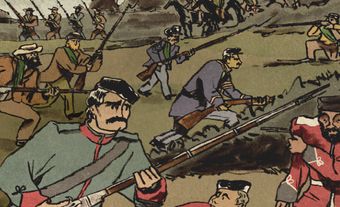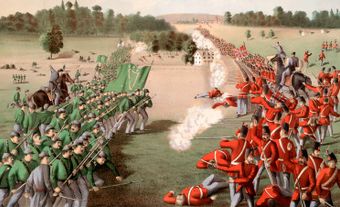The Battle of Ridgeway is also known as the Battle of Lime Ridge or Limestone Ridge. It was fought on the morning of 2 June 1866, near the village of Ridgeway and the town of Fort Erie in Canada West (present-day Ontario). Around 850 Canadian soldiers clashed with 750 to 800 Fenians — Irish American insurgents who had crossed the Niagara River from Buffalo, New York. It was the first industrial-era battle to be fought exclusively by Canadian troops and led entirely by Canadian officers. It was the last battle fought in Ontario against a foreign invasion force. The battlefield was designated a National Historic Site in 1921.

Fenian Raids
Fenians were members of a mid-19th century movement to secure Ireland’s independence from Britain. They were a secret, outlawed organization in the British Empire, where they were known as the Irish Republican Brotherhood. They operated freely and openly in the United States as the Fenian Brotherhood. Eventually, both wings became known as the Fenians.
Fenian raids were armed incursions into Canadian territory between 1866 and 1871. The Fenians intended to seize and hold Canadian territory in return for Irish independence. It was thought that this would create a crisis in Britain — perhaps even a war between Britain and the US — and weaken British resolve in Ireland once a planned rebellion broke out there.
American authorities tried to prevent the Fenians from mobilizing on the US-Canada border. But the Fenians raided Campobello Island, New Brunswick, in April 1866. In late May, they began to amass enough guns and ammunition to arm about 20,000 insurgents.

Fenian Incursion
On 1 June 1866, an advance party of 1,000 heavily armed Fenians crossed the Niagara River from Buffalo, New York. They were led by John O’Neill, a former US Cavalry officer who had served in Ohio and West Virginia during the American Civil War.
The Fenians quickly captured the undefended town of Fort Erie, Canada West, along with its railway and telegraph terminals. They arrested the town council and the customs and border officials at the international ferry docks. They also forced the town’s bakery and hotels to provide them with breakfast. After cutting outgoing telegraph lines, the insurgents seized horses and tools, which they used to build trenches and fortifications. By the end of that first day, the Fenians controlled the Niagara frontier from Black Creek in the north to Fort Erie in the south. They were within marching distance of the Welland Canal, the only navigable naval passage between Lake Ontario and Lake Erie.

Canadian Response
During the Fenian Raids, some 22,000 Canadian militia volunteers were mobilized along with several British infantry units stationed in Canada. As the Fenians took positions around Fort Erie, two Canadian militia units were deployed to Port Colborne near the village of Ridgeway: the 2nd Battalion, Queen’s Own Rifles (QOR) from Toronto; and the 13th Battalion of Hamilton “Rileys” (The Royal Hamilton Light Infantry). As senior officer in the field, 13th Battalion commanding officer Lieutenant Colonel Alfred Booker took command of the brigade. Booker was a prominent Hamilton auctioneer and a volunteer officer.
On the night of 1–2 June, Booker was ordered to take a train to Ridgeway and march to the nearby town of Stevensville. There, he was to join an arriving column of British troops and Canadian militia for a joint counterattack against the Fenians, who were believed to be positioned near Fort Erie. Booker was ordered to avoid the Fenians on his march to join the arriving column.

The Battle of Ridgeway
The Canadians and the British did not know that the Fenians had marched to a strategic ridge just north of Ridgeway during the night of 1–2 June. The ridge ran along the Canadians’ route to Stevensville. Booker had been warned that the Fenians had laid an ambush on the ridge. He proceeded to march towards the Fenian positions and engaged them despite his orders to avoid contact.
In the first hour of the battle, the Canadians appeared to prevail, driving Fenian skirmishers from their positions. Then something went wrong: to this day, it is not clear exactly what. Contemporary sources reported that Canadian militiamen mistook Fenian scouts on horseback for cavalry (mounted soldiers). Booker’s order to form a square, designed to defend against a cavalry charge, exposed the Canadians to intense Fenian rifle fire. Booker quickly canceled the order. But he was unable to reform the inexperienced Canadian ranks now under intense and accurate fire. Other sources indicate that troops mistook a company of 13th Battalion infantry for British troops relieving them and began to withdraw; this triggered a panic among other troops who mistook the withdrawal for a retreat.

DID YOU KNOW?
According to Peter Vronsky, historian and author of Ridgeway: The American Fenian Invasion and the 1866 Battle That Made Canada, this iconic representation of the Battle of Ridgeway (above) is not accurate. The Canadians are depicted in British redcoats. But Canadian volunteers were actually dressed in both redcoats and green tunics, depending on which battalion they fought with. Meanwhile, the Fenians were dressed in blue Civil War uniforms or civilian clothing. Many wore green scarves. Also, the battle was not fought in the traditional line formation depicted here.
Seeing the chaos breaking out in the Canadian ranks, John O’Neill quickly ordered a bayonet charge. This completely routed the inexperienced Canadians. The Fenians took and briefly held the town of Ridgeway. Then, expecting to be overwhelmed by British reinforcements, they quickly turned back to Fort Erie. They fought a second battle there against a small but determined unit of Canadians holding the town.
On the night of 2–3 June, O’Neill realized that US Navy gunboats would intercept any Fenian reinforcements crossing the Niagara River. The Fenians attempted to cross back into the United States but were arrested by the US Navy. They were eventually released on the condition that they would return to their home states.

Aftermath
The Canadians lost nine soldiers killed in action. They are known today as the “The Ridgeway Nine.” Thirty-three men were wounded, some severely enough to require amputation of their limbs. Four more Canadian militia volunteers eventually died in the months following the battle, either of wounds sustained or of disease contracted at Ridgeway.
The Canadians were well deployed. They arrived in the vicinity of the Fenians within several hours of the incursion. But they were poorly trained and unprepared for combat. Troops had scarce ammunition, no food or field kitchens, no proper maps, no provisions for medical care, no canteens for water, and no tools for the proper care of their rifles. Only half of the troops had practiced firing their rifles with live ammunition. They were no match for the Fenians, who were well-armed and well-supplied veterans of the American Civil War.
The militia were the responsibility of Canada West’s attorney general and minister of militia, John A. Macdonald. The inefficiency of the militia was whitewashed by two military courts of inquiry. They found that the blame lay with inexperienced frontline troops, who panicked and broke; not with the officers who led them or the government that undersupplied and undertrained them. The Queen’s Own Rifles (QOR) were disparagingly nicknamed “Quickest Outta Ridgeway.” The 13th Battalion were dubbed “The Scarlet Runners.”

Legacy and Significance
The history of the Battle of Ridgeway was muted in Canadian military heritage. The Canadian government was reluctant to acknowledge the veterans of the battle for nearly 25 years. In 1890, the Veterans of ’66 Association held a protest at the Canadian Volunteers Monument at Queen’s Park, Toronto. They laid flowers at the foot of the monument on 2 June, the 24th anniversary of the Battle of Ridgeway. In 1899–90, after a 10-year campaign of protests and lobbying, the Canadian government sanctioned a Fenian Raid medal and land grants to surviving veterans.
The protest became an annual memorial event known as Decoration Day; graves and monuments of Canadian soldiers were decorated with flowers. For the next 30 years, Decoration Day would be Canada’s popular national military memorial day. The first “remembrance” day, it was commemorated on the weekend nearest to 2 June. It acknowledged fallen Canadians in the Battle of Ridgeway, the North-West Resistance (1885), the South African War (1899–1902) and the First World War (1914–18). (See also Remembrance Day.)
In 2013, the City of Toronto and the Town of Fort Erie petitioned the federal government to restore the Ridgeway Nine to Canadian military memorial heritage by including them in national Books of Remembrance in Ottawa. However, no action was taken.
See also: Fenian Raids Education Guide; Fenian Raids Timeline; Fenian Raids Collection; Irish Canadians; Thomas D’Arcy McGee; Patrick James Whelan.


 Share on Facebook
Share on Facebook Share on X
Share on X Share by Email
Share by Email Share on Google Classroom
Share on Google Classroom


